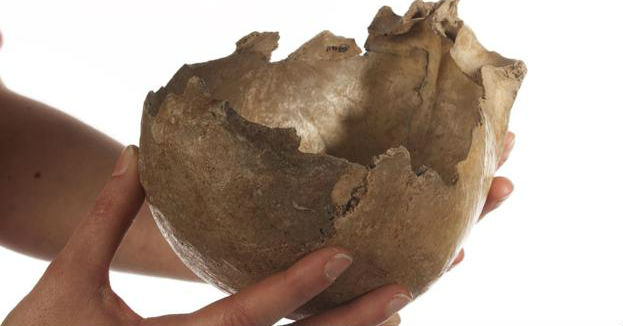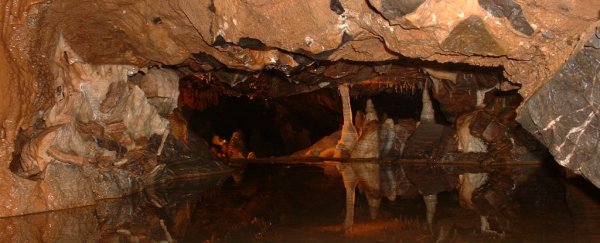Of all the taboos humans hold onto, cannibalism is by far the most significant. But in the rest of the animal kingdom, it's a surprisingly common practice. Mothers eat their babies, babies eat their mothers, babies eat each other, and we all know what happens to male mantises midway through sex…
But there's growing evidence to suggest that humans haven't always shunned the act of eating each other. Archaeologists have uncovered de-fleshed human bones on the floor of Gough's Cave in the UK, and finds elsewhere in Europe suggest that these were leftovers - not burials.
Back in 1903, the remains of a human male were uncovered inside Gough's Cave - a 115-metre-deep, 3.4-km-long cave located in Cheddar Gorge of Somerset, England.
Named the Cheddar Man, he is said to be Britain's oldest complete human skeleton, dated to approximately 7150 BC. But that's not his only distinction - the Cheddar Man appears to have suffered a violent death, and shows signs of perhaps being cannibalised.
While the cannibalisation of the Cheddar Man himself has never been proven, archaeologists have in recent years found more human remains in the cave, and in 2015, they were finally ready to say that they were the results of cannibalism, not burial.
"We've found undoubting evidence for defleshing, disarticulation, human chewing, crushing of spongy bone, and the cracking of bones to extract marrow," one of the team, Silvia Bello, from London's Natural History Museum, told BBC News at the time.
Since the last excavations took place in Gough's Cave in 1992, Bello and her colleagues have been analysing the artefacts and marks left by its prehistoric inhabitants, and have dated these bones to around 15,000 years ago.
Considering that burials were practically unheard of at the time, and that archaeologists around the world had already found evidence of humans bones being treated as regular garbage, the researchers' best bet was that the Gough Cave population was eating each other.
"A recurring theme of this period is the remarkable rarity of burials, and how commonly we find human remains mixed with occupation waste at many sites," said one of the team, Simon Parfitt.
If that makes you a little uncomfortable, wait for it, because it wasn't just adults being eaten in this cave.
"A three-year-old child and two adolescents all had the tell-tale marks of being nibbled on," Melissa Hogenboom reports for the BBC.
Of course, cannibalism isn't the kind of assumption archaeologists and anthropologists tend to throw around lightly. In fact, Hogenboom says it makes them downright uncomfortable, because a) it's a dark reminder of the worst elements of human nature, and b) it's incredibly difficult to prove.
The most difficult aspect of proving cannibalism is being able to separate bones that had been gnawed on for food, and bones that had been defleshed after death for cultural or ritualistic purposes.
As Bello points out, cuts on animal bones are quickly accepted in the scientific community as the result of butchery and eating, but the moment you try to make the same connection with human remains, you're going to have a bad time.
The key to distinguishing cannibalism from ritual deflating, she says, is whether they've been smashed - presumably to suck the marrow out - and if there are any discernible signs of sucking or chewing on the surface. (I hope you're not eating right now.)
"Some of the modification, particularly for the fingers, [shows] they were probably chewing to suck the grease off," says Bello. "The presence of human tooth marks on human bones is probably the best evidence of cannibalism."
While Bello and her team had already concluded last year that Gough's Cave contained evidence of our ancient ancestors eating each other, a recent paper describing a separate site now strengthens this assumption.
German researchers found 45,000-year-old Neanderthal bones in the caves of Goyet in Belgium that were marked with the same sorts of bites and cuts found in the Gough's Cave bones, and compared those to marks found on the bones known food sources - horses and reindeer.
"These indications allow us to assume that Neanderthals practised cannibalism," one of the team, Hervé Bocherens from Tübingen University, told Léa Surugue at the International Business Times. "The many remains of horses and reindeer found in Goyet were processed the same way."
So why did they do it?
 Trustees of the Natural History Museum
Trustees of the Natural History Museum
That part isn't clear, and of course, every community could have a different reason for wanting to chow down on another person or two. And if you thought distinguishing butchery from ritual defleshing was difficult, pinning down a motive is even more complex.
Basically, it comes down to two main possibilities: our ancestors either ate each other because they were starving and desperate, or they chose to do so as some kind of ritualistic or cultural practice.
Interestingly, Bello says they found no evidence that the human remains found in Gough's Cave had met a violent death, which suggests that they weren't killed for their flesh, but it was taken advantage of once the owner no longer needed it.
She told Hogenboom that while it makes sense that they would have eaten their own corpses during a particularly lean winter, she's thrown by the fact that they found skulls that had not been gnawed on like the other bones to get the meats and juices out - they had been deliberately carved into a kind of cup or bowl (see image above).
"Instead, Bello thinks the people living in Gough's Cave made the skull cups as part of a ritual or burial practice. Quite possibly they drank out of them," says Hogenboom. "If that is the case, eating others' flesh may have been a cultural practice, rather than something done purely for survival."
Without further research, we'll probably never know the true motivations behind the cannibals of Gough's Cave, Goyet, and elsewhere around the world, but at least we can be sure that we've come a long way from our ancestors.
